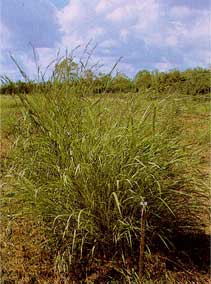Change in savanna fire regime due to invasion of exotic grasses
Invasive exotic grasses can increase fuel loads, leading to changes in fire regimes of invaded ecosystems by increasing the frequency, intensity and aerial extent of fires.
 Andropogon
gayanus Kunth. (Gamba grass), a tall perennial grass from Africa,
is invading ecosystems in the Top end of northern Australia.
Andropogon
gayanus Kunth. (Gamba grass), a tall perennial grass from Africa,
is invading ecosystems in the Top end of northern Australia.
To determine if Gamba grass alters savanna fire regimes, we compared fuel loads and fire intensities at invaded sites with those from native grass savannas.
Savanna invaded by Gamba grass had fuel loads up to seven times higher than native grasses. This higher fuel load supported a fire that was on average eight times more intense than those recorded in native grass savannas at the same time of year. The fire intensities recorded was the highest early dry season fire intensities ever recorded in the Northern Territory.
These results suggest that Gamba grass is a serious threat to northern Australia's savannas, with the potential to alter vegetation structure through modification fo the fire regime.
Further information:
Rossiter, N.A., S.A. Setterfield, et al. (2003). "Testing the grass-fire cycle: exotic grass invasion in tropical savannas of northern Australia."
D'Antonio / Vitousek (1992) Biological invasions by exotic grasses, the grass/fire cycle and global change. Annual Rev. Ecol. Syst. 23: 63-87.